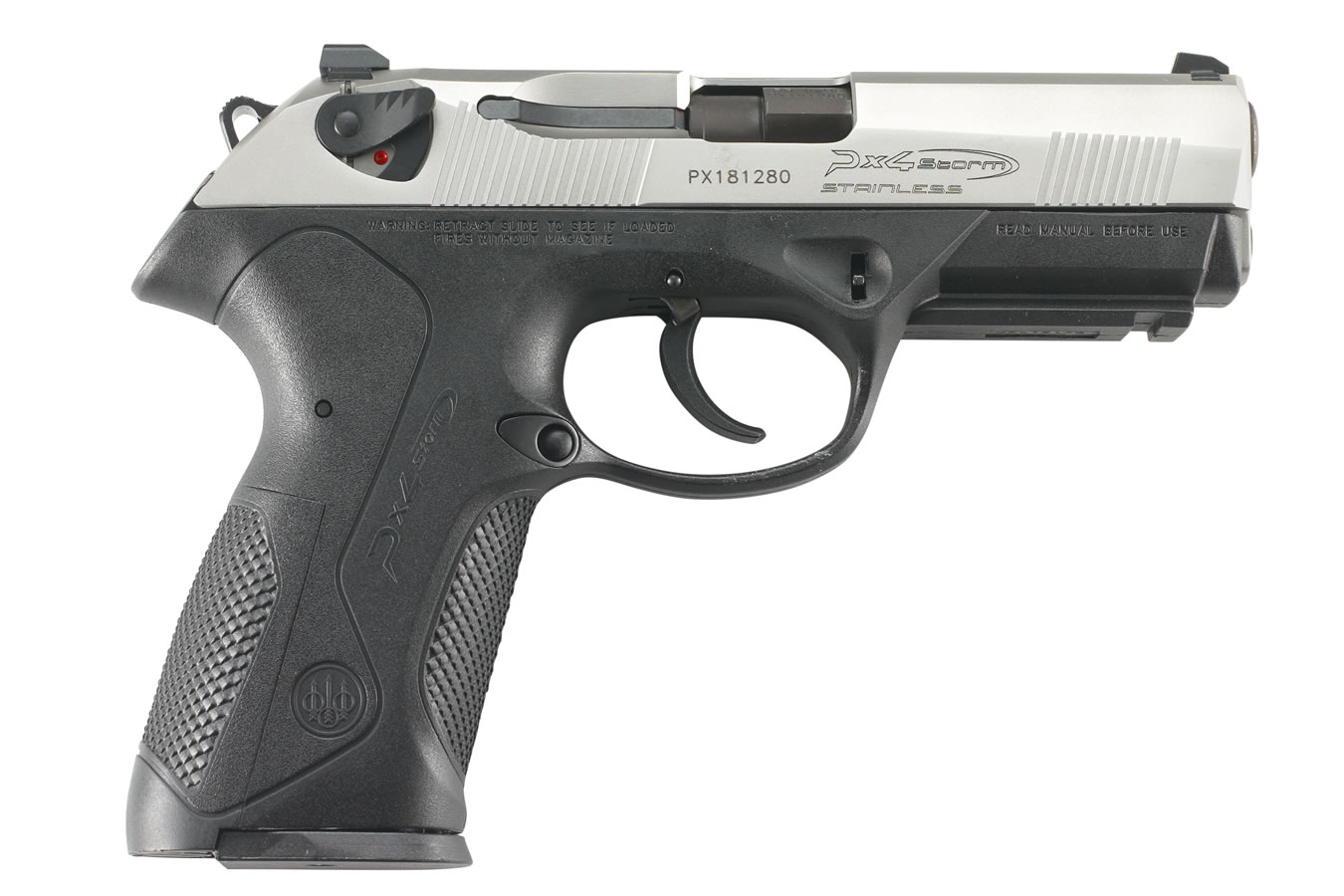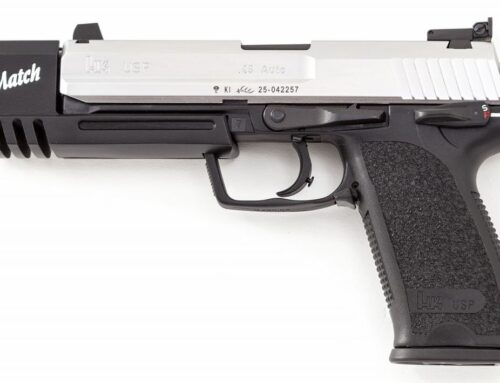It’s been called Beretta’s best kept secret. A gun which would run through anything. The unassuming Px4 Storm series of pistols easily drift under the radar at gun counters, their black polymer frames lost amongst the striker-fired mob and the external hammer mostly hiding itself within the curved rear slide profile. These pistols have been getting incredible praise if you look for it yet they remain largely uncommon within the gun community. What’s the deal?
The Px4 Storm, companion sidearm to Beretta’s Cx4 Carbine which I had previously reviewed exactly one year ago, has been around for just shy of twenty years. Available in 9mm, .40 S&W, and an “SD Type F” version in .45 ACP, I’ve rarely encountered any of these guns for sale and I don’t recall having ever seen anyone using one at a range. Beretta makes good stuff and I had never questioned the Storm’s reliability but from looking at pictures I think I can say what its first shortcoming is: Looks.
Appearance matters, especially when you’re stepping into the shadow of the venerable M9 and 92 series. These “previous generation” handguns are beyond famous and have seen service all across the globe including in our own Military. The large size and open top slides with exposed barrels gave them an attractive and commanding presence, none of which have carried over to the Px4. Instead the Storm looks samey at best and unappealing at worst. The back of the slide and frame being rounded off may help provide some shielding for the exposed hammer but I don’t think they do the gun any favors in the visual department.
Next would likely be the polymer frame. The Px4 came in during a rapid shift in the industry where polymer framed handguns were primarily striker-fired, the new hotness which almost everyone seemed to gravitate toward and often continue to. Those still wanting external hammers probably wanted metal frames and, once again, the fame of the 92 series completely overshadowed its younger smaller Storm sibling.
Third would be its operating system. Have you ever heard of the Beretta 8000 “Cougar?” I’ve only heard of them long enough to have forgotten about them and never once saw one in person. Turning to Wikipedia, it appears the Cougar and the Px4 share the same rotating barrel operation. Compared to nearly every other semi-automatic handgun on the market which uses a Browning style tilting block action (except for the 92!), an action which is known and very well trusted, trying to sell people on a far less common system can be a tall order in itself. Not helping are previous attempts by other companies to make rotating barrel pistols, most if not all of which had been colossal flops.
Here’s looking at you, Colt 2000. Go look it up, it’s an interesting piece which would make for a great review! The rotating barrel operation may be the only shared trait between these two but guns like the 2000 leave lasting impressions and create stigmas which are very difficult to overcome.
Compared to the Colt’s 2 years of production, Beretta’s current rotating barrel offering is still in production and is apparently quite revered by those who use them. It’s been a long time coming but I’ve had a chance to send some rounds through the full size 9mm Storm and, not gonna lie here, but…
I don’t get it.
Again, I’m not about to question its reported reliability. Certainly not with less than a box of rounds through one. Yet what trigger time I had left me with more questions than answers, enough that I had to try it again another day to see if there was anything I might have missed. The trigger pull and controls felt like dead ringers for the 92 series. The polymer frame made it a little lighter and a little thinner in the grip with good front and back texturing but the sides are completely smooth which makes for a very slippery hold. The ambidextrous safety/decocker felt like it was pulled straight off the 92 series (which it probably was.)
The flush 9mm magazine holds 17 rounds and is unfortunately not compatible with the 92. The slide catch is fairly small but still accessible. Flipping the decocker rewards you with the same positive hammer snap of the 92 series, in a blind test I doubt I could tell the two apart. The same can be said for the trigger. During the second range session I brought along my 92A1 for a side by side test and couldn’t find any real difference between them.
The magazine release is another matter and is by far my biggest gripe about the Px4. There’s a nice wide housing around the button which serves as the base for extra factory mag release options if you can find them for sale, but the one which comes on the pistol is an unexpectedly tiny textured button raised above the housing. Pair this with firm spring tension and after only a couple of magazine drops my thumb was filing all sorts of complaints. Every other detail about the Px4 is perfectly serviceable as is but that teeny tiny mag release has got to go!
No joke, the one other detail which stood out to me over any 92 has to do with the rotating barrel. It felt exactly as I would have expected with more of a clunky/gritty recoil impulse rather than a smooth linear one which you find in most other handguns. I’m sure with enough range time you could get used to this but I didn’t see it doing anything to tame muzzle flip or provide faster follow-up shots as some have claimed. It just felt like a gritty polymer framed 9mm. In addition, the Px4 is a taller and wider gun than the hammerless opposition. Parts and upgrades are available but they pale in comparison to any flavor of Glock ever made. Canik, Walther, and HK likely have Beretta beat here as well.
The Px4 isn’t without some tricks up its polymer sleeve, though. Unlike its all metal framed cousins the Storm has a swappable backstrap, though as far as I can tell there are only two sizes to choose from. The trigger control unit is another where the entire assembly can pop out of the back of the grip, much like the Sig Pro series. While I couldn’t tell you what sort of options might be available here I did come across a competition trigger pack.
The safety/decocker has a similar level of adjustment much like how the 92 had with the “F” and “G” types, both of which are also available with the Px4. I believe the F is the standard decocker while the G is for cocked and locked carry.
Disassembly will be quite familiar to striker fired operators. In front of the trigger guard is a dished out section with a small tab on either side. Pull both tabs down and the slide comes off the frame. It’s easy enough and with much more subtle controls over the 92 but I’ve got to admit I much prefer the 92’s takedown.
Overall the Px4 is like a smaller, lighter Beretta 92, which places it squarely into uncomfortable territory. Compared to the 92 series the Px4 is better for carry use and even more so with the compact version of the Storm, but now we’re diving deep into the striker-fired market which has dominated the carry gun territory for about as long as the Storm has been around.
From my own perspective, while I love shooting pistols with external hammers I don’t plan on carrying one. When I do reach for one to take to the range I no longer have any concerns with trying to keep it compact, thus I go for full sized veterans like the Sig P226 and the Beretta 92.
The Px4 lives on in a fairly exclusive market of double stack polymer framed handguns with external hammers, joined by the likes of the Sig Pro series and CZ P-07. From everything I’ve seen or heard the Storm sidearms are quite robust but those who would gravitate toward these kinds of firearms over striker-fired alternatives are about as few as there are options within this segment. Handguns with rotating barrels are even less common with the Smith & Wesson M&P 5.7 being the only other which comes to mind.
Despite the looks and the feedback from the rotating barrel action, both of which are subjective, the Px4 still represents a solid value. The guns themselves are not expensive and having seventeen rounds of nine mil in a flush mag beats out their full sized older siblings. They’re worth trying out if given the opportunity and if you decide to add one to your collection it will provide a unique curiosity on top of being dependable.
Right now at the Range we happen to have a clean used example for sale, as well.








